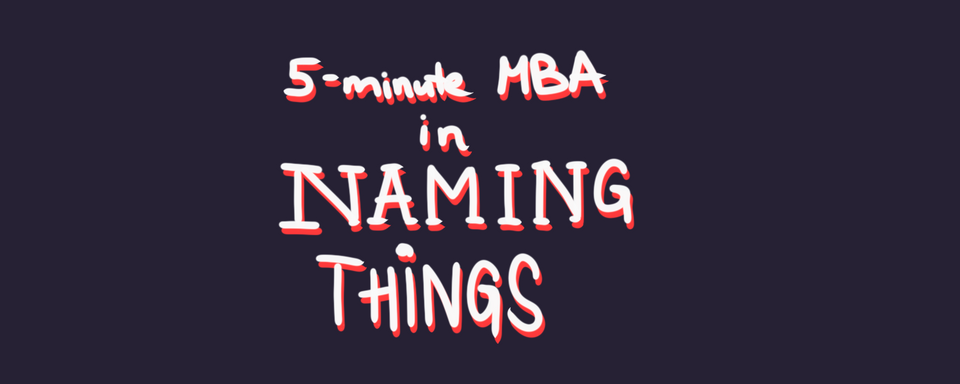5-Minute MBA in Naming Things: The Ultimate Guide to Coming Up With Better Names

Chances are you have to name something.
I am not talking about naming your kids or your favorite pet. Today we are going to talk about naming something practical:
- A project 🎶
- A startup 💡
- A product 📱
- A company 🏢
This is an easily-digestible resource, which should take your understanding about naming from so-so to o-ho! in 5 minutes.
This post covers:
- Why Even Your Friend's Mom Has an Opinion About Names
- Practical Considerations
- Types of Names
- Best Practices
- Name Storming Technique
- Summary
Prelude: Everyone Has an Opinion
"I don't like it!" - some random person
I like to joke that branding - at least the visual aspect - and names are the two things where everyone seems to have an opinion.
Why?
Because on a surface level, naming seems trivial.
Not everyone knows orbital mechanics but most definitely most people know words. That's why everyone thinks they are a naming expert.
Trying to name a technical product for your organization? Be sure to run it by your friend's mom because she might have something to add 😑

Naming Something: Before and After
Whenever I had to name something (companies; corporate spin-offs; products; creative projects; websites) in the past there was always a clear before and after.
Before you name something, there is no consensus. People discuss name ideas, offer suggestions, and want to see if "we might come up with something better after another round of brainstorming".
After you name something, people usually come to terms with the new name.
My guess is that this has to do with cognitive dissonance and our inclination to look for the best possible outcome for ourselves.
A Name Is Important But...
As one of my peers would say: "Just because it is important it doesn't mean it's sufficient."
Simply put, in 99.9% of cases a name does not decide over success or failure.
A name is an important part of a brand. But it is just a part after all.

Instead, a brand is built across many touchpoints over time.
Nonetheless, this guide will show you how to come up with great names without overcomplicating things.
Practical Considerations: First Things First
"So come on and chick-ity-check yo self. Before you wreck yo self." - IceCube
Knowing what problem to solve is at least half the effort. This also holds true for naming.
Think through the following items before you start your quest to name X:
- Naming vs. Renaming: Are you starting from a blank slate or do you have to take an old name into consideration?
- Context, Context, Context: How will this name be used? By whom? When? Why?
- Naming Conventions: Are the common standards for the type of context you find yourself? (e.g.: all Germany-based startups seem to have a number at the end of their name → Bett1.de; Check24; Auto1 ... I mean this half-jokingly but you get the gist 😏)
- Constraints, Constraints, Constraints: What do you like? What don't you like? What is a must-have in the name? What's an absolute no-go in the name?
If you think through these questions for more than a second then you're already doing better than most.

Types of Names
Let's have a look at common types of names 👁 👄 👁
I'll start with the categories I believe are easiest to use for naming.
Neologism
Neologisms are new word inventions.
Examples: Twitter; Google; Adidas
Make them up. The sky is the limit.
The main challenge is to fill the name with meaning. If done well you can create a "Category of One" in your audience's head.
Description
Literally spells out what it is about.
Examples: Under Armour; Salesforce
Descriptive names are great because they work quickly. The audience understands what it is about. The main challenge with descriptive names is finding a name, which is not taken yet (trademark; domain; etc.).
Visual
Names, which evoke a strong mental image.
Examples: Stripe; Amazon; Apple; Oculus
The nice thing about visual names is that you can fill them with brand narratives (e.g. the Apple that fell on Isaac Newton's head and triggered his creative energy) but chances are that most of the common images are already trademarked and occupied.
An easy way is to look for visuals, which are far off the standard associations. Once, I was naming a FinTech startup and a coworker suggested going with "Lampshade Financial".
Kind of genius - IF you can fill it with the right brand narrative.
Hybrids
Combinations of words.
Examples: Gumroad; Instagram; Facebook
I worked for a Berlin-based company called AppLift. They did user acquisition for mobile apps, hence they helped to lift the app in the app store rankings.
App + Lift = AppLift
FinTech + Leapfrogging Technology = FinLeap
... and so on and so on.
Hybrids are kind of cool because chances are high that you will find a unique combination with available domains and untapped associations.
People
Naming after real or imaginary people.
Examples: Goldman Sachs
Founder names, imaginary characters. All goes.
Location
Country of origin effect.
Examples: Marin Software
If your location has positive associations (German engineering; Taiwanese semiconductor technology; American media; etc.) you can use it to your advantage.
If you were an electronic music tooling company you could easily call yourself Berlin Techno Tools.
Might be relevant for your case.
Alliteration
Names with the same sound or latter at the beginning of each word.
Examples: Bed, Bath & Beyond; Best Buy
Those are interesting for punny names and if done well they roll off the tongue easily. But I believe, it's a tough one to get right.
Go for it if you're into rhymes.
Acronyms
Examples: EY (formerly Ernst & Young); BMW; AT&T
Works if you've been in business for a while.
Also, don't forget that even if the name looks short it sounds longer. Each letter is one syllable or more.

Best Practices: What You Should Keep in Mind
Here are a couple of quick pointers to remember when looking for a name:
- 🙊 Pronunciation: Does the audience need a Ph.D. in Language Science to pronounce the name?
- ⌨️ Writing It: Can someone easily type it into the browser window if they've heard it on a podcast?
- 🦍 David vs. Goliath: Is there a big dog in the same ring who shares a similar name?
- ✅ Domain Availability: Can you get anything other than the .party and .bio domains for this name?
- 💜 Liking It: Do you like the name? Don't forget you'll say, type, and share this name quite frequently. You better not hate it.
Name Storming 🌩: A Technique to Come Up With Better Names
I'd like to share a quick case study of my most recent naming project.
In 2021, I started a new business.
My challenge was:
- Offering: Selling online courses to teach 'how remote works'
- Audience: Selling to managers of remote teams (B2B)
- Hypothesis: B2B customers want to buy from businesses vs. buy from individuals
- SEO/Keyword: The name had to include the word "remote" since it became synonymous with the type of work I was training.
- Top-level Domain: I wanted to register a name where I could own a .com domain.
To generate some good options I used the Name Storming technique.
Here's a screenshot of one of my ideation sheets, which eventually led me to arrive at my winning combination 👇

After generating 289 idea permutations, one word sprung to my attention: fabric
The term ‘fabric’ was not even in my initial consideration. What did it for me when I realized that remotefabric.com was:
- available for $12/yr on Google domains
- and looked kick-ass in the browser window
Why fabric?
Fabric is an underlying structure of something and this is exactly what I wanted to uncover with my business: Identifying how remote works (from the inside out).
That’s why it’s remote fabric 🧬
Learn the Name Storming technique in under an hour and get access to the Name Storming Google Sheet template for your own naming project.
Congrats, You've Graduated from the 5-minute MBA in Naming Things 🎉
I hope this short guide was helpful.
If you end up using any of these tips, I'd love to hear from your project and include it in this post.
Please get in touch and let's be internet homies 🙌





